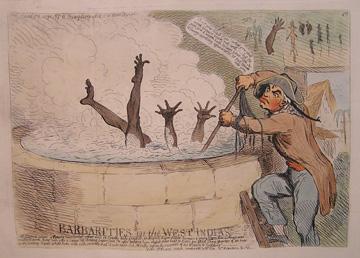Museum expands collection

International Slavery Museum’s first Collecting Cultures acquisition: announced on International Human Rights Day
The International Slavery Museum has announced its first acquisition following a funding boost from the Heritage Lottery Fund in 2014 to grow collections at the Museum.
It is a copper engraving by the famous British caricaturist James Gillray, published in 1851, depicting an infamous scene of cruelty described during a parliamentary motion for the abolition of the slave trade.
The engraving shows an English slave driver punishing a young enslaved African because he was too sick to work. The inscription on the engraving describes how he was thrown
“into a copper of boiling sugar juice, and after keeping him steeped over head and ears for above three quarters of an hour in the boiling liquid, whipt him with such severity, that it was near six months before he recovered of his wounds & scolding”.
The engraving has been purchased as part of the Museum’s Transatlantic and Contemporary Slavery Collecting Project, part of the Heritage Lottery Fund’s Collecting Cultures programme.
The Museum is announcing the acquisition on International Human Rights Day which marks the United Nations General Assembly's adoption and proclamation, on 10 December 1948, of the Universal Declarationof Human Rights (UDHR), the first global enunciation of human rights.
Stephen Carl-Lokko, Curator, International Slavery Museum said:
“The acquisition of this item is a significant opportunity to enhance our collection of objects related to the history of abolition in Britain.
“The text of the drawing refers to the common, brutal activities that took place on British plantations in the West Indies, as well as referencing the prominent British abolitionist, William Wilberforce.
“It is hard to look at the engraving, but it gives us an opportunity to reflect on the past, and also reminds us of how human rights continue to be violated and abused everyday in the modern world.
“The object is currently undergoing conservation. We hope to have it on display in the coming year”.
The International Slavery Museum highlights the international importance of enslavement and slavery, both in a historic and modern context. Working in partnership with other organisations with a focus on freedom and enslavement, the Museum also provides opportunities for greater awareness and understanding of the legacies of slavery today.
To learn more about please visit our website or contact us at collectingcultures@liverpoolmuseums.org.uk
Free entry
Open daily 10am-5pm
Albert Dock Liverpool Waterfront Liverpool L3 4AX
www.liverpoolmuseums.org.uk/ism
Telephone 0151 478 4499
@SlaveryMuseum
Search ‘International Slavery Museum’ on Facebook
Notes to editors
International Slavery Museum
The International Slavery Museum opened in August 2007. It is situated on the third floor of the Merseyside Maritime Museum at the Albert Dock. It is the only national museum in the world to cover transatlantic slavery and its legacies as well as modern forms of slavery and enslavement. It is also an international hub for resources on human rights issues and campaigning.
About National Museums Liverpool
National Museums Liverpool comprises eight venues, including some of the most visited museums in England outside of London. Our collections are among the most important and varied in Europe and contain everything from Impressionist paintings and rare beetles to a lifejacket from the Titanic. We attract nearly 2.7 million visitors every year. Our venues are the Museum of Liverpool, World Museum, the Walker Art Gallery, Merseyside Maritime Museum, International Slavery Museum, Border Force National Museum, Sudley House and the Lady Lever Art Gallery.
About the Heritage Lottery Fund
Using money raised through the National Lottery, the Heritage Lottery Fund (HLF) aims to make a lasting difference for heritage, people and communities across the UK and help build a resilient heritage economy. From museums, parks and historic places to archaeology, natural environment and cultural traditions, we invest in every part of our diverse heritage. HLF has supported over 36,000 projects with more than £6bn across the UK. www.hlf.org.uk.
